3 Life Interfering Levels of Consciousness

3 Life Interfering Levels of Consciousness
- If you were to look at the different results in the different areas of your life, which ones would you like to elevate or advance?
- What types of conditions, thoughts, or levels of Consciousness do you think may have been maintaining the unconscious processes generating these results?
- What new conditions, thoughts, or levels of Consciousness are required as a primer for our Ordinary Blueprint to have new substance for our unconscious processes?
In our previous article, entitled, CBT, Consciousness and Mental Processes, we asked you to ponder the above three questions. We also explained that these questions would become clearer as we continue with the articles in this series and explore CBT and Consciousness. Please see the previous articles in this series for a deeper understanding of the present one.
In this present article, we are introducing the first three levels of Consciousness that are life interfering. In subsequent articles, we will introduce the additional levels of Consciousness.
- Self-loathing [1]: We may know or hear of some individuals who loathe, hate, detest, or despise themselves. This is their being. This is their decree about themselves, and this is how they view themselves. As a result, these individuals see life as sorrowful, sad, unhappy, meager, and miserable. The main theme, and the main characteristic of this degree of Consciousness, is “losing face,” or “Shame.” As such, the main emotions are embarrassment, indignity, or humiliation, and individuals at this degree of Consciousness are likely to see everything through such a lens. As a result, these individuals go through life through a process of self-destruction, or destruction of others, both at a conscious and at an unconscious level. In practice, we have met several patients at this degree of Consciousness, and most of the time, they have been a victim of Adverse Childhood Experiences (ACES)[2], that are shame prone, and have failed to process them properly. Sexual abuse at an early age is an example. Individuals at this degree of Consciousness tend to have low self-esteem and tend to be withdrawn and shy.
- Blameworthiness: The second degree of Consciousness (going from least to most developed) is that of individuals who tend to describe themselves as unforgiving, vengeful, or vindictive. In the eyes and in these individuals’ minds, life is just wicked, wrong, bad, and evil; and the main characteristic of this degree of Consciousness is culpability, blameworthiness, or guilt; which then makes “blame” these individuals’ main emotion. This also becomes the lens through which these individuals see everything. Just like the first level, individuals at this degree tend to go through life through the process of self-destruction and the process of destruction of others. For these individuals, remorse, victimhood, and masochism are often common, and their unconscious blameworthiness often leads to psychosomatic disease and suicidal behaviors.
This degree of Consciousness also highlights the common characteristic of the first state of awareness, known as suffering. A state where someone sees life and everything about life through the lens of victimhood [3]. In such a case, life is always happening to him; he has no say, no power, whatsoever, and everyone is to blame, particularly those on the outside. Needless to say, he blames himself as well, and the cycle of self-blame and external blame continues. - Hopelessness: The third degree of Consciousness can be seen in individuals who criticize, attack, and condemn themselves. They view life as awful, terrible, dreadful, and hopeless; and the characteristic of this degree of Consciousness can be summarized as indifference or apathy. Pain and distress are their main emotional bases and the lens through which they see everything. Giving up, or resignation is the process they use to go through life. To them, both resources and resourcefulness seem to be nonexistent. As such, they tend to be totally dependent on others or on society, and they are typically indifferent as to whether they continue to live or die.
These individuals are also those who have given up. They have given up on themselves. They believe it is not worth trying, and as a result, do not even bother to try. They tend to go through life with sheer resignation, as if they were merely existing, and are just waiting for their “final days.” As a healthcare provider, working with someone at this degree of Consciousness can be most draining.
- What are your overall thoughts on these first three levels of Consciousness?
- Where do you see yourself?
- Where do you see your patients, and what does it take for you to help them shift to a higher level of Consciousness?
These questions will become clearer as we continue with our subsequent articles in this series. Meanwhile, we invite you to ponder upon them; and we look forward to hearing from you.
See you soon,
Karen and Mardoche
P.S. Please join us for our CBT module on CBT and Action, scheduled for March 10th, 7pm EST. We look forward to welcoming you.
[1] Barrington, Jo. “Self-Loathing: Where Self-Loathing Comes From and How to Stop It.” PsychAlive, 22 Dec. 2020, www.psychalive.org/self-loathing/.
[2] “Adverse Childhood Experiences (ACEs).” Centers for Disease Control and Prevention, Centers for Disease Control and Prevention, 3 Apr. 2020, www.cdc.gov/violenceprevention/aces/index.html.
[3] Kaufman, Scott Barry. “Unraveling the Mindset of Victimhood.” Scientific American, Scientific American, 29 June 2020, www.scientificamerican.com/article/unraveling-the-mindset-of-victimhood/.








